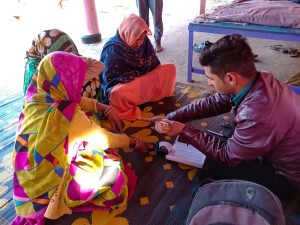FPOs and Financial Inclusion: Theory & Reality

Photo by NEERAZ CHATURVEDI on Shutterstock
Like any other research team, we started by understanding and unwrapping the research hypothesis word by word — ‘whether FPO’s can be an effective vehicle for financial inclusion for small and marginal farmers’. Having shared our insight about FPO’s in our previous articles, we thought it was time we shared our journey in understanding about ‘financial inclusion’. With respect to India, the mass exclusion of people from the formal banking system that hindered economic growth at the bottom of the pyramid — was a worrying fact. Inclusive banking began, in spirit, with the nationalisation of banks in 1969 when 14 major commercial banks were nationalised. But the real thrust on financial inclusion (FI) came in 2005 when the Reserve Bank of India (RBI) highlighted its significance in the annual policy statement of 2005–06. It urged banks to work towards reaching out to the masses, offering banking services down to the hinterland. FI as a policy initiative entered the banking dictionary only after the recommendations of the Rangarajan Committee in 2008 (Rangarajan, 2008). There have been many and different interpretations of FI(1) but the definition we found most comfortable is taken from CRISIL: “The extent of access by all sections of society to formal financial services such as credit, deposit, insurance and pension services.”(Crisil, 2018) CRISIL rate’s India’s financial inclusion score at 58 on a scale of 100, which according to CRISIL is above average. Crisil measures Financial inclusion on four parameters — banking penetration, credit penetration, deposit penetration & insurance penetration.
So how do things fare on the ground especially with the marginalised communities? To understand further, we consulted policy experts (researchers) and practitioners in the field to understand how they viewed FI. Amongst practitioners, FI is predominantly interpreted as synonym to banking access as it (banking penetration) was unanimously acknowledged as a strong performer. Additionally, linkages of government subsidies and schemes to PMJDY account, enables in achieving transparency by enabling direct bank transfer. MFI’s (micro finance institutions), on the other hand have been vocal on the importance of access to credit as the important component of financial inclusion. Discussion with MFI’s made us realise two critical issues surrounding India’s financial inclusion objectives. Firstly, the availability of banking doesn’t mean its access. To take an analogy, having a school or hospital in the remote region doesn’t guarantee improved education or health facilities. Similarly, the availability of banking infrastructure does not guarantee FI. Secondly, the need to find innovative ways to lend to groups without assets (for example: tenant farmers, tribal farmers) as one of the key challenges. In India, a large portion of the farmers are tenant farmers, i.e. one who takes the farm on short term lease and undertakes agriculture. These farmers, having no or limited land (as collateral) cannot get access to formal credit facilities especially via regular banking infrastructure. One curious observation made during the discussion was that none of the organisation, baring one, highlighted the role of insurances (or social security for example pension) as an important element in achieving FI.
With the PM Jan Dhan Yojana, access to bank accounts have reached to over 25 crore users in rural/semi-urban branches (dated 24th June, 2020), which is a substantial progress. Insights from practitioners made us realise that the regulations around opening an account has greatly reduced, evident from the number of accounts; but maintaining and transacting various other products and services (of financial inclusion) required couple of important components — namely Aadhaar, Collateral, and active mobile number, which acted as a barrier to avail those services (average deposit in JD Accounts are around INR 3500). Over the last couple of months qualitative research has highlighted to us substantial gaps to be addressed to improve on financial inclusion. As a closing remark, we would like to quote a famous reference in management corridors, ‘You get what you measure.’
Endnotes
World bank defines financial inclusion as ‘means that individuals and businesses have access to useful and affordable financial products and services that meet their needs — transactions, payments, savings, credit and insurance — delivered in a responsible and sustainable way’.
Reserve Bank of India (RBI) defines it, ‘universal access to a wide range of financial services at a reasonable cost. These include not only banking products but also other financial services such as insurance and equity products’.
Crisil . (2018). Crisil Inclusix. Mumbai.
Rangarajan, D. C. (2008). The Committee of Financial Inclusion. RBI.
This research was developed as part of the Bharat Inclusion Research Fellowship.
